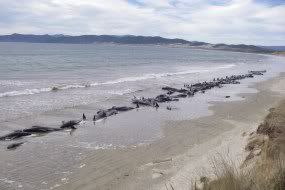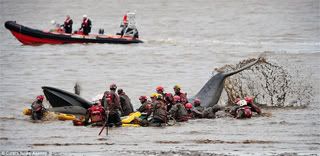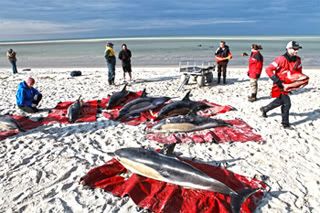The word is "strandings".

photo credit AAP & New Zealand Department of Conservation
Last month we heard of the 99 pilot whales stranded off Farewell Spit in New Zealand. This area is common for strandings and experts believe it is due to the relatively shallow waters in combination with tidal changes. It has been suggested that in areas like this, the sudden ascent of the bottom topography creates a situation where a whale's echolocation it uses to navigate will bounce around the area, confusing the animal and impairing navigation. Thirty-six whales died during stranding and the New Zealand Department of Conservation decided to put 33 whales down due to repeated re-strandings and significant stress and physical deterioration. Only seventeen whales from the pod were successfully refloated.
A stranding off Queensland, Australia this past summer didn't even get that happy of an ending. A baby humpback was separated from its mother and beached at Moreton Island. The calf was estimated to be only one to two weeks old and would have still been very dependent on its mother for food and protection. Speaking with a local expert on the matter, I found this stranding was particularly controversial - partly because of Sea World's involvement and partially due to the poor execution of the rescue attempts. As you may have seen in an earlier post, it is being debated whether Sea World always has the animal's best interest in mind during a stranding. My source suggested that an additional autopsy would have been beneficial to a certain Sea World vet when this calf stranded. Overall, the execution of the rescue efforts were questioned in that the whale was initially left on the beach while local authorities waited for Sea World responders, after which it was physically dragged back to sea - which would have been remarkably stressful for such a young animal. In the end the whale was euthanized after stranding a second time two days later.
Farther North in Lincolnshire, England another young whale was separated from its mother and stranded in the Humber estuary. Over 50 emergency workers worked for eight hours to dig a trench and successfully lead the whale back to sea where its mother had been spotted. The reunification of mother and calf is crucial in young whales, particularly those who are migrating as they may not yet know the area or direction to swim in.

photo credit Caters News Agency
It is important for scientists to gather data during stranding events (or during autopsies in the case of failed rescues) so that we may come to understand why some of these events occur, how we can better respond and what we might be able to do to avoid them. Following the Deepwater Horizon spill in the Gulf of Mexico, hundreds of dolphins washed up dead or dying. One particular dolphin is being nursed back to health in Gulfport, Mississippi and is offering information into what caused the death of other dolphins in the area. The Institute for Marine Mammal Studies is currently not at liberty to reveal what exactly their findings have been, but they have said that finding a live dolphin was like "finding the black box from an airplane after a crash."
Recently another mass stranding has been in the news in Cape Cod, Massachusetts. Nearly 120 common dolphins have been stranding themselves since 12 January along the coast of Wellfleet. The hook of Cape Cod is another common area for cetacean strandings, much for the same reasons as Farewell Spit. Scientists are troubled by this stranding event because the number of animals involved in just these past few weeks is close to the total number of animals seen throughout the entire year. What's more is that all of the animals appear to be healthy. Despite this, over 80 dolphins have died. Some of the surviving individuals are being monitored by satellite tags to watch where they are going and how they are faring. Generally, the trend seems to be encouraging: the dolphins are swimming out into deeper waters and are not re-stranding. However, a large group of around 400 dolphins has been spotted off the Cape...It is unclear at this time whether they will head into the bay or continue their journey safely on the outside.

photo credit IFAW
So what should you do if you find a stranded cetacean? First of all, contact your local stranding network where experts will be able to instruct you further and make their way to the scene. If you don't know who your local stranding network is, contact animal control or the local police who will be able to help you get in touch with the correct people. If the animal is on it's back or side, and if you have someone to assist you, gently roll the animal onto it's stomach and try to keep it wet with sea water - careful not to get any water in it's blowhole. Minimize your contact with the animal and keep other people and dogs away. Listen to the experts' instructions and be careful. Whales are dolphins are wild animals and a stranded cetacean is in a stressful situation and can injure or transfer diseases to you.
Volunteers are continuing to work along the shores of Wellfleet to rescue the stranded dolphins. If you can, please consider donating to the International Fund for Animal Welfare (IFAW)'s critical need fund to help these animals.
More information at IFAW, who is leading the stranding response team.
No comments:
Post a Comment